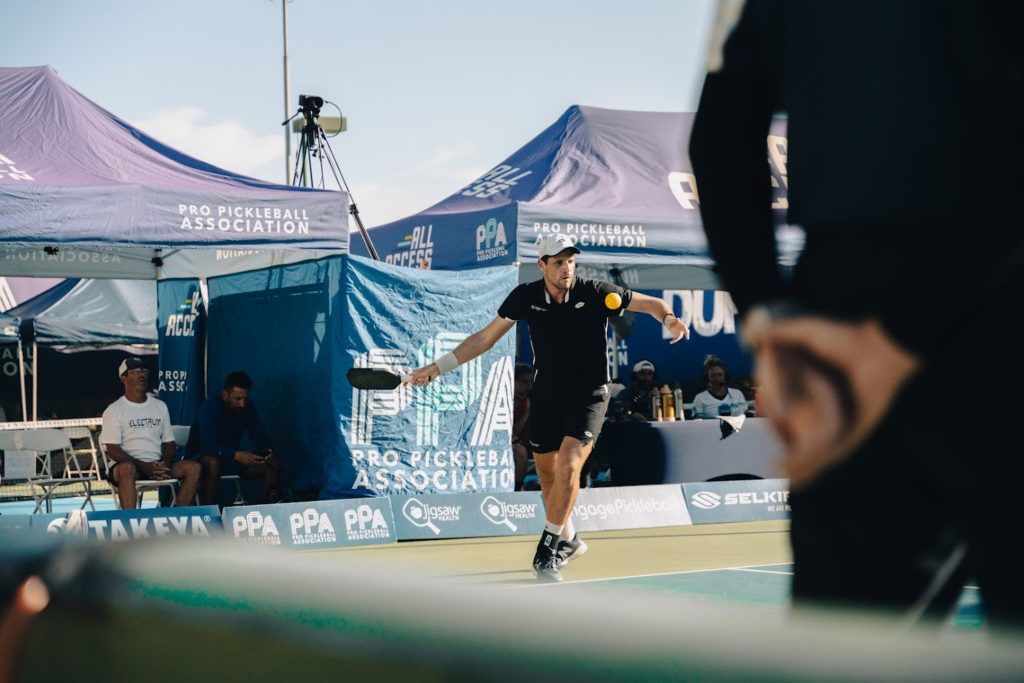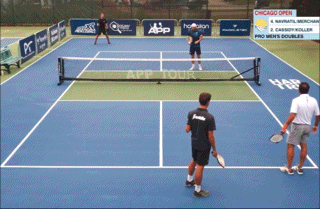

Creative Changes to the Serve
Soon after Pickleball became the fastest rising sport in the country, the powers that be declared a provisional rule introducing the drop serve, which was soon overshadowed by players innovating a “chainsaw” serve. This and other variations of the original Morgan Evans serve that used a spinning ball toss, created headlines such as “26 Aces in a Pro Mixed Doubles” and “The Next Gen Serve.” They all shared a common denominator. The server manipulated the ball with spin prior to contact with the paddle.
To Manipulate or not to Manipulate the Ball
The original serve rule required an underhand serve defined by a specific relationship between the paddle and the server’s anatomy that was difficult to enforce, since contact between the paddle and ball happens in 1/500 of a second.
The provisional service rule avoided this conflict by relaxing the rules on the paddle swing as long as the ball is dropped free of any manipulation. This respected the goal of serving underhanded since a dropped ball without manipulation doesn’t bounce over 34” high.
The Rule Committee has not made a judgement on the spinning ball toss or the different techniques used to apply spin to the ball but, those details pale in comparison to the fact that a ball given a high degree of spin prior to paddle contact result in a screwball bounce far exceeding the spin that a paddle alone could generate.
This obvious contradiction between no manipulation of the ball prior to paddle contact vs. spin-the-heck-out-of-the-ball prior to contact was never envisioned by the Founding Fathers of Pickleball. So let’s see whether history offers any insights.
History of Creating Excessive Spin

Finger-spinning the toss is not new to paddle sports. In table tennis serving, no spin may be imparted to the ball by the fingers. This was not always so. Finger-spin reached a stage where skilled players could produce impossible-to-return services and the game became farcical. Finger-spinning was universally banned in 1937.
In 1977, the sport of tennis was turned on end by the “double strung spaghetti” racquet. Brainchild of German tennis player, Werner Fischer, it created screwball bounces as well as headlines. “Mike Fishbach (ranked 200) beats US #1 Stan Smith using his spaghetti racquet” and “unranked George Govern beats Ilia Nastase using spaghetti strings.” Ironically shortly afterwards, Nastase using his own double strung spaghetti racquet defeated Villas who won 3 of 4 Grand Slams that year. In 1978, The New York Times reported that the ATP and ITF had banned the use of such creative stringing declaring that the extreme and unpredictable bounces had “changed the character of the game.”
The Character of the Game
Does weaponizing the pickleball serve by manipulating spin on the tossed ball prior to hitting the serve change the character of the game?
The Pickleball Founding Fathers had the foresight to create a compelling and chess- like game based on maintaining the delicate balance between offense and defense by the following rules:
- One can only score when serving: Advantage SERVER.
- The server must serve underhand and gets only once chance: Advantage RETURNER.
- A returned serve must bounce before anyone on the serving team can hit: Advantage RETURNER.
- Winning a point doesn’t count for the returning side, it simply gives them a side-out: Advantage SERVER.
Although pickleball is a serve-and-volley game, these four rules make it competitive where close battles and changing serves may not result in points. Yet momentum changes and runs in scoring do occur. Weaponizing the serve, as well as scoring rally- style, would upset this delicate balance and “the character of the game.”
Pickleball’s Unique Character is based on its Unique Elements
THE BALL
The plastic ball bounces low, with the average hit off the ground at 24”. The ball has 40 holes which limit the spin to 1500 rpm (tennis can reach 4800 rpm). It is regulated to not bounce over 34” when dropped from 78” high. The ball is not difficult to hit, which is why points in pickleball last an average of 9 shots compared to only 3 in tennis.
THE PADDLE
The paddle is solid and small (limited to a combined length and width of no more than 24”). Its surface texture is regulated to limit enhanced spin. The paddle can produce a ball speed between 25mph and 40mph, a third the speed of that in tennis. As a result, during matches the ball is hit with touch (defensively) 45% of the time and with power (offensively) 55% of the time.
THE SPIN
High speed camera analysis shows that after bouncing, all balls have top spin. Top spin on a 5.0 player’s drive is 1475 rpm and after bouncing increases to 1875 rpm. Surprisingly, a flat drive hit with 0 rpm develops top spin of 950 rpm after bouncing. A back spin or slice drive may bounce lower but still has 325 rpm of top spin. In the end, spin is a minor factor in pickleball whereas in tennis the ball can reach 4800 rpm.
THE COURT
The pickleball court at 880 square feet is 1/3 the size of a tennis doubles court. Having four players in such a compact area leads to an intensity of action in which the ball is in play for 28 minute per hour. In tennis the ball is in play for only 11 minutes per hour.
— HEY! We send a free e-newsletter every Wednesday morning with all sorts of news, stories and more just like this. Subscribe at thedinkpickleball.com/signup. Boom! —
Conclusion
The character of Pickleball is due to the unique combination of a low-bouncing ball, hard paddle and small court resulting in a game where neither serve nor spins dominate. This opens the door for a game balanced between offensive and defensive play, patience and strategy, and both age and gender neutral.
Manipulating spin on the ball prior to serving is not consistent with existing pickleball that minimize spin from the paddle surface and minimize the bounce on the ball. Perhaps it is time to establish a neutral ball toss and join other paddle and racquet sports.
by Jerry Li, “Pickleball Made Simple”… Amazon Statistics from OncourtOffcourt.com.

Love Pickleball? Join 100k+ readers for free weekly tips, news & gear deals.
Subscribe to The DinkGet 15% off pickleball gear at Midwest Raquet Sports









